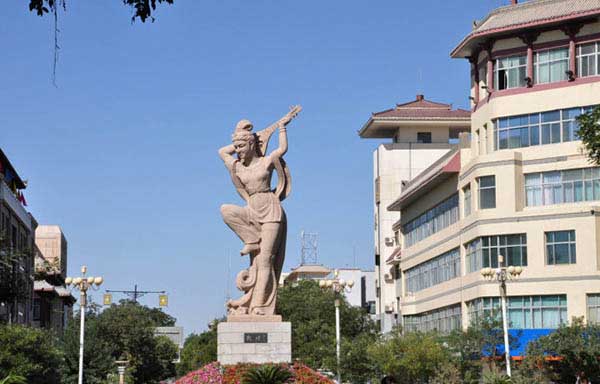- By admin
- In DunhuangArt
- 2016-05-15
Dunhuang art -- Scenes from the Life of the Buddha, ink and colours on silk

From Cave 17, Mogao, near Dunhuang, Gansu province, China Tang dynasty, 9th century AD
Symbols and stories from a Buddhist context
At the time of the birth of the historical Buddha, Shakyamuni, it was foretold that he would either become a chakravartin (Universal Emperor) or a Buddha. In Buddhist art Shakyamuni is often shown with the symbols of the chakravartin to indicate that he defeated the World of Suffering. Here they have been combined with scenes from Shakyamuni's life. On top a Chinese officer represents the skilled general; a fashionably clad Chinese lady represents the royal consort; his treasure chest; the Wheel of the Law, and below a Chinese official representing the faithful minister, followed by the royal elephant and horse.
The lower section shows two miracles that accompanied Shakyamuni's birth. Immediately following his birth, cold and warm water appeared to wash him. In Indian art this is shown being assisted by naga (snakes), but here Chinese dragons appear in the clouds. The last scene shows Shakyamuni taking his first footsteps, in each of which a lotus flower blossomed. The attendants are plump and look remarkably similar to representations of women from the Imperial court from the same period. This indicates the close links of this outpost on the Silk Road with central China.
R. Whitfield, Art of Central Asia: The Ste-2, vol. 1 (Tokyo, Kodansha International Ltd., 1982-85)
R. Whitfield and A. Farrer, Caves of the thousand Buddhas: (London, The British Museum Press, 1990)
Related destinations
Why Choose Us?
We are the top Silk Road tour operator based in Dunhuang, China. We focus on providing well designed Silk Road China Tours with resonable price and thoughtful service.
- Easy & carefree booking
- The best value
- Great travel experience
- Locally operated
Hot Tours
-

6 days Gansu tour to Binglingsi, Xiahe and Langmusi
Tour type : Private tour Price : from *** Destinations : Lanzhou - linxia - Xiahe - Langmusi - Hezuo - Lanzhou -

12 Days Gansu Highlights Tour
Tour type : Private tour Price : from *** Destinations : Xian – Tianshui – Lanzhou – Xiahe – Langmusi – Hezuo – Zhangye – Jiayuguan - Dunhuang -

10 Days Silk Road Classic Tour
Tour type : Private tour Price : from *** Destinations : Xian - Zhangye - Jiayuguan - Dunhuang - Turpan - Urumqi -

5 Days Zhangye - Alxa youqi Highlights Tour
Tour type : Private Tour Price : from *** Destinations : Zhangye - Alax youqi - Zhangye


